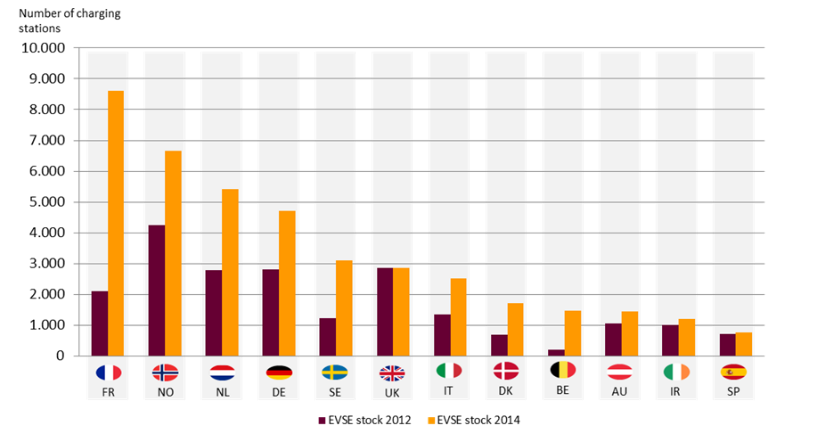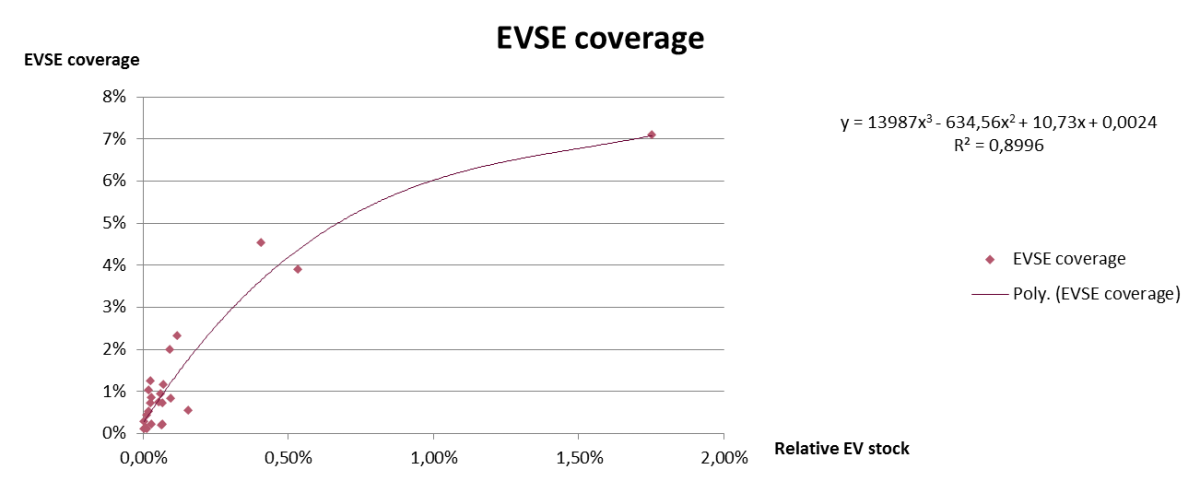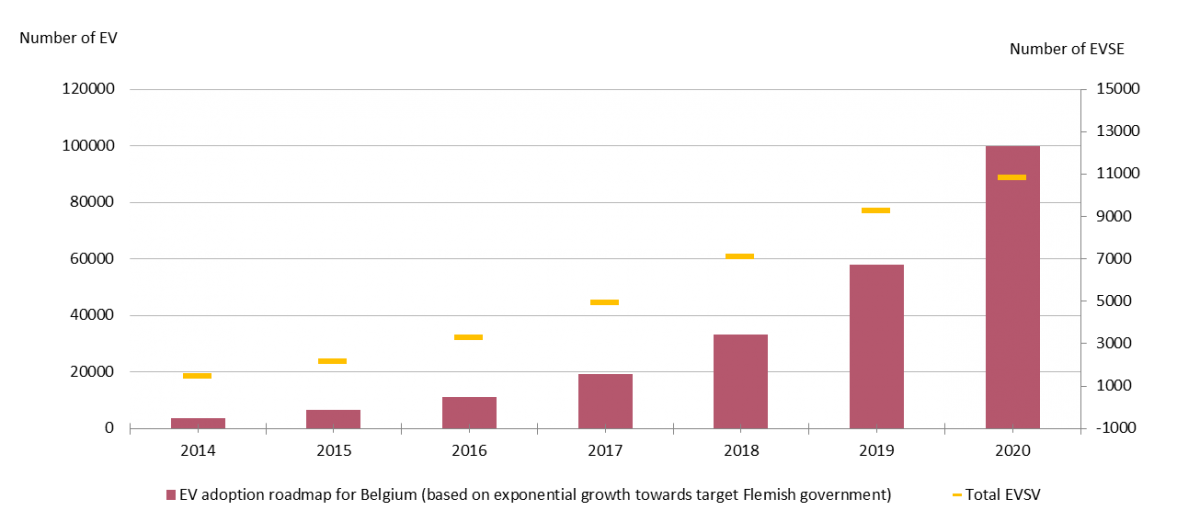Control Room of the Future

A study on the need of public charging infrastructure to foster sucess of electric vehicles in Belgium.

Electric vehicles (EV) have been embraced as a way to reduce both local as well as global pollution in the transport sector. Traditionally, low range combined with a lack of charging infrastructure and the high prices of batteries made electric vehicles relatively unattractive compared to combustion engines. During the last five years however, a combination of factors such as technology improvements, government support and mass production have made the electric vehicle a true competitor for the combustion engine powered vehicles.
Charging at home remains the most dominant way of charging an electric vehicle. It does not require additional planning or waiting to recharge the vehicle. Furthermore, it is also less expensive to invest in a small but slow domestic charging station than to invest in faster alternatives. Although most of the trips done by car are covered by the average range of a Battery Electric Vehicle (BEV): 80% of the Europeans are driving less than 100km per day [1]), public charging stations remain critical for longer journeys such as intercity travels and for households without facilities for home charging.
In this article, Sia Partners analyses the need for public charging infrastructure. A relationship is established between the success of EV in a country and the density of public charging stations. Based on this relationship, an estimate is developed for the case of Belgium. The study also covers the different stakeholders and their respective barriers and incentives to invest in public charging infrastructure. The geographical scope is limited to Europe with a focus on Belgium.
Home charging is one of the most important ways to charge EV, given that the vehicle is typically parked at a residence for the longest portion of the day. In the initial stage of EV roll out, home charging is estimated to account for almost 80% of the total charging [3]. In Norway – one of the early adopters of electric vehicles, almost 95% of the BEV and the PHEV owners have access to a private charging station at home.
Home charging by itself is however not sufficient to enable mass adoption of electric vehicles. On the short term, public charging infrastructure is critical to provide range confidence and extend the range for limited range BEV drivers, allow long-distance travel for long-range BEV drivers, and improve the value proposition those drivers [8]. A recent survey from the G4 questioner [6] showed that only 18% of the EV users think that there are enough public charging stations available in the cities, and less than one fourth has a charging station available near their residence.
On the long-term, public charging will remain necessary as in Europe, around 65% of the households do not have a private parking space. An analysis of the parking patterns in Europe shows that an average car resides about 10% of the time on a dedicated parking space at work and more than 50% of the time in the public area (see Figure 1). This means that if a mass rollout of EV is to take place, charging at home will need to be supplemented with public and semi-public charging infrastructure.
![Parking patterns per country (Sia Partners analysis) [4, 5]](/sites/default/files/styles/freeratiomedia_1200/public/image/picture/2020-06/figure_1_2.png?itok=MUimky_-)
Figure 1 Parking patterns per country (Sia Partners analysis) [4, 5]
This section will investigate how much public charging infrastructure is typically needed for a given level of EV penetration. The methodology used for this analysis consists of correlating the EV penetration with the density of installed public charging infrastructure for a number of European countries. Two metrics have been used to assess the density of charging infrastructure per country:
1. Electric Vehicle Supply Equipment (EVSE) coveragee per EV or the number of cherging stations per EV
2. EVSE coverage of the road network or the number of charging stations per km of road
Over the years countries such as France, Norway, The Netherlands, Germany and Belgium took large initiatives to increase the number of (semi-) public charging points (Figure 3).

Figure 2 Electrical Vehicle Supply Equipment (EVSE) or charging stations for a selection of European countries in 2012 and 2014
The correlation between relative EV penetration and the ratio between EVSE and EV is also shown in Figure 3. The best performing countries such as the Netherlands and Norway had an EVSE public coverage per EV of nearly 12.39% and 14.84% in 2014 which means there is about 1 public charging station for every 7 EV. For countries with a very low EV penetration, a high EVSE coverage per EV does not necessarily relate to a high EV penetration. For example, Ireland has a remarkable over-coverage of more than two public charging stations to one EV on the road. Even if the country is in transition and that a lag period will always precede concrete results, Ireland currently lags behind with a coverage of 219% and only 0,03% of the personal vehicles being an EV (2014).
![EV penetration (relative) and EVSE coverage per EV for a selection of European countries in 2012 and 2014 [7]](/sites/default/files/styles/freeratiomedia_1200/public/image/picture/2020-06/figure_3_3.png?itok=IHz9-LEy)
Figure 3 EV penetration (relative) and EVSE coverage per EV for a selection of European countries in 2012 and 2014 [7]
A comparison of the level of EV penetration to the EVSE coverage of the road network shows a clear positive correlation (Figure 4): countries with high levels of EV uptake typically have a higher EVSE coverage of their road network. It is also interesting to note that the best performing countries have almost doubled their EVSE road network coverage in two years. Norway increased its road network coverage from 4,53% (2012) to 7,08% (2014) and the Netherlands from 2% (2012) to 3,89% (2014). Belgium on the other hand, lags behind with an EVSE road network coverage of only 1% (2014).
![Penetration (relative) in function of the EVSE coverage of the road network [10]](/sites/default/files/styles/freeratiomedia_1200/public/image/picture/2020-06/figure_4_2.png?itok=JMgcLxoR)
Figure 4 EV Penetration (relative) in function of the EVSE coverage of the road network [10]
Based on the EVSE coverage of the road network and the EV penetration, the input from different countries and different years has been plotted (Figure 5). Using power regression, a good relation between EV penetration and the EVSE coverage was established for the data range (0-2% EV penetration). Based on this relation, an estimate can be made for the number of public charging stations that would be needed to reach a certain objective of EV uptake.

Figure 5 EVSE road network coverage and EV penetration plot (Sia Partners Analysis)
For Belgium, if the objective is to have an EV penetration of approximately 1% or 55.000 cars, the availability of public charging station would have to reach an EVSE road network coverage of approximately 6%. Concretely, this means that the total number of EVSE has to increase from approximately 2000 to 9280 publicly available charging stations. This is five times more as registered today. For a more ambitious target of electrifying approximately 2% or 110.000 cars of the total vehicle park, the EVSE road network coverage has to increase to 7,5% or 11.550 public charging stations. This would represent an estimated investment cost comprised between 75 M€ and 94 M€ (including permitting, mobilization, labor, transformer and hardware pole) between 2016 and 2020 [13], with level 2 and 3 curb side charging stations. If taking into account DC Fast Charging stations, at the same penetration level as in the Netherlands, 650 of those stations would be needed in the total mix. The total cost would then rise and be comprised between 103 M € and 129 M € by 2020.
Sia partners, based on a political target estimation of the Flemish government (100000 EV by 2020), used an exponential function to predict the total amount of Electric vehicles evolution (linear approach). Assuming the EV adoption will evaluate on exponential growth towards the target, the EV stock may be predicted throughout the years. Indeed, the roadmap for the installation of public EVSE in Belgium can be established based on the equation from Figure 5. As a result, Figure 6 displays the roadmap of the total number of EV and the related amount of EVSE needed to support this penetration.

Figure 6 Roadmap to EV and EVSE adoption for Belgium
Several actors have an incentive to invest in public and semi-public charging infrastructure depending on the location of the charging point and the type of charging technology. Most obviously, manufacturers of EV have a clear incentive to set up charging infrastructure as can convince more customers to buy EV. At this stage, they are the only private actors that have an incentive to invest in the more expensive DC charging stations without government subsidies. Examples are Tesla’s and Nissan’s fast charging network in the US.
The second actors that have a clear long term incentive to invest in public and semi-public charging infrastructure are utilities and electricity suppliers. Indeed, in a context where efficiency and low industrial consumption are bringing down the electricity sales, electrification of the vehicle park presents a unique opportunity to boost electricity sales. For example, E.ON has invested in more than 100 charging stations spread all over Europe. In Denmark, the company has also acquired the former Better Place Denmark’s 770 charging stations for Electric Vehicles (Copcap, 2014).
Thirdly, actors that provide services related to the exploitation of a charging station have an incentive to invest. They might be attracted to invest in slow charging AC and fast charging DC infrastructure but at this stage it is unclear if they have an attractive business case to absorb the full installation cost of a public charging station. One example of a charging station provider is Fastned that is now developing an entire EV fast-charging network across the Netherlands, with plans to continue to expand into the rest of Europe. At the moment, 15 million euros have been invested in Fastned with 3 million coming from distributed, small-scale investors. Another example is the joint venture of TOTAL and Allego which decided to invest in 12 public available EV fast charging stations (43 and 50 kW).[9]
Fourthly, parking owners, retailers and business owners might have an incentive to invest in semi-public charging infrastructure (mainly slow charging AC) in order to attract additional customers or for branding purposes.
Finally, the government might decide that public charging stations are a public good when others do not have a business case or incentive to do so. However, as mentioned in several studies [8], governments should be weary to not distort market mechanisms and install public charging station at the wrong sites.
Given the incentives discussed above, one might wonder why the investment in public charging infrastructure is going slow – even in countries that are highly suitable for EV adoption. This can be explained by a number of barriers. The most important ones are summarized below.
Firstly, there is the high cost of owning and installing charging infrastructure. One of the biggest challenges for the EV sector is to ensure commercial viability in the deployment of charging infrastructure in the future (McKinsey, 2014). Secondly, demand for charging equipment is currently hampered by the small size of the EV market. Thirdly, because commercial charging has to compete against home charging or the fact that EV drivers are reluctant to pay the high costs of public charging equipment when charging at home is easy and significantly less expensive.
In addition to this, non-economic barriers should also be mentioned. There might a psychological barrier to use EV – especially in conservative circles. Furthermore, legal barriers exist due to regulation and lobbying from conventional fossil fuels companies. Finally, technical barriers can be cited as well. The most obvious one is the lack of standardisation of plugs.
Public charging stations are essential both on the short term to increase range confidence as well as on the longer term in order to provide charging options to households without access to home charging. Based on an analysis of the relationship between the EV penetration and public charging infrastructure, Sia Partners estimates that for the case of Belgium, a fivefold increase (to approximately 9300 public charging stations) is necessary in order to reach an EV penetration of 1% of the total vehicle park. For an EV penetration of 2% or 110.000 EV, the number of charging stations would have to increase to 11.550. This latter case would represent an estimated total cost ranging from 75 M€ to 94 M€. A number of actors have a fundamental incentive to invest in public charging stations, the two most outspoken being utility companies and EV manufacturers. This being said, it is clear that a number of barriers such as high cost, regulatory uncertainty and lack of standardisation currently hamper deployment of public charging stations. As a result, the government has a crucial role in removing these barriers during the “early adopters” phase. It should however be careful to not distort the market mechanism and take poor siting decisions. Sia Partners recommends that the government refrains from fully subsidising public charging infrastructure but focuses on providing a clear regulatory framework and on removing barriers such as lack of standardisation of charging plugs.
Alexei Blokhine, Jérome Calderan, Alexandre Pirson and Maxime Snick, Consultants Energy, Resources ans Utilities
[1] The Charging Point 2011, Is it easy to charge an electric car? Do you need special equipment?
[2] International Energy Agency, Implementing Agreement – Hybrid & Electric Vehicle, Charging Equipment, Paris.
[3] Amsterdam Roundtable Foundation and McKinsey & Company The Netherlands 2014, Electric vehicles in Europe: gearing up for a new phase?, Amsterdam.
[4] Vlaamse Overheid, Mobiliteitsontwikkelingen, Brussels.
[5] European Commission 2016, Individual mobility: From conventional to electric cars, Brussels.
[5] The Chargemap 2016, Statistics regarding charging points in France, France.
[6] Afdeling Onderzoek Gemeente Utrecht 2014, Elektrisch rijden in de G4, Utrecht.
[7] European Automobile Manufacturer’s Association 2014, ACEA electric vehicles registrations 13-14, Brussels.
[8] National Research Council 2015, Overcoming barriers to deployment of plug-in electric vehicles, Washington.
[10] European Central Bank Statistical Data Warehouse 2016, New passenger car registration, Brussels.
[11] International Energy Agency 2016, Global EV Outlook 2016, Paris.
[12] Baker Tilly Belgium 2015, Elektrische wagens: groene fiscaliteit in uw voordeel, Brussels.
[13] Inside EVs 2014, How Much Do Public And Home EV Charging Stations Really Cost?